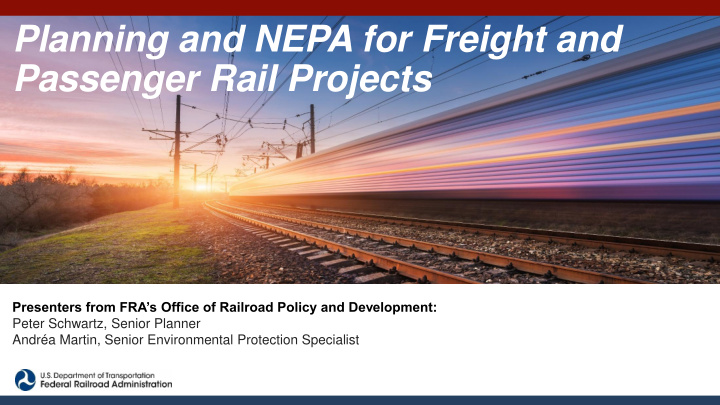



Planning and NEPA for Freight and Passenger Rail Projects Presenters from FRA’s Office of Railroad Policy and Development: Peter Schwartz, Senior Planner Andréa Martin, Senior Environmental Protection Specialist
A New Approach to Project Development and NEPA • Getting projects ready for implementation FASTER MORE MORE LESS EFFICIENTLY SUCCESSFULLY CONFUSION • Substance stays the same – but refined sequencing/process 2
Project Lifecycle – Systems Planning to Project Implementation SYSTEMS PLANNING PROJECT DEVELOPMENT/NEPA PROJECT IMPLEMENTATION Regional Rail Plans Service Planning Final Design State Rail Plans Preliminary Engineering Construction Environmental Analysis Alternatives Analysis Begin NEPA NEPA Project Process Decision Application Identification 3
Existing Process – PRIIA to Present • Tied to $8B in ARRA funding appropriated for project development and delivery PRIIA, passed in 2008 • Focus on application requirements • Focus on eligibility • Focus on immediate-term pipeline • All project development occurring during NEPA or after • All Alternatives Analysis during NEPA • Wide use of tiering NEPA documents • Focus on Service Development Plan ARRA, passed in 2009 4
Existing Process – PRIIA to Present SYSTEMS PLANNING PROJECT DEVELOPMENT/NEPA PROJECT IMPLEMENTATION Regional Rail Plans Service Planning Final Design State Rail Plans Preliminary Engineering Construction Environmental Analysis Alternatives Analysis Begin NEPA NEPA Project Process Decision Application Identification 5
Existing Process – PRIIA to Present SYSTEMS PLANNING PROJECT DEVELOPMENT/NEPA PROJECT IMPLEMENTATION Regional Rail Plans Service Planning Final Design State Rail Plans Preliminary Engineering Construction Environmental Analysis Alternatives Analysis Begin Tier 1 Begin Tier 2 Begin NEPA NEPA NEPA Tier 1 NEPA Project Tier 2 NEPA NEPA Process Decision Decision Process Application Identification Process Decision 6
Lessons from Existing Process • Vaguely defined projects at start of NEPA • NEPA timeline extended due to project development work • Development/screening of alternatives rushed • Grant-funded projects faced challenges • Projects implemented with Tier 1 NEPA documents • Planning projects for Tier 1 NEPA/SDP • Inefficiencies of concurrent NEPA and project development 7
New Policy Priorities – Environmental Streamlining and One Federal Decision • MAP-21 (2012) • FEIS/ROD, Preferred Alternative in DEIS, (Sec. 1319) • FAST Act (2015) • Streamlining Sec. 11503 • One Federal Decision (OFD) (2017) - E.O. 13807 • 2-Year timeline for EIS • Early agency coordination • Mandated for “Major Infrastructure Projects” • OFD principles advised for other projects 8
Improved Process for Project Development/NEPA • Enter into NEPA with a better-defined project • Strong preliminary Purpose and Need • Preliminary range of reasonable alternatives • Deemphasizing tiering except for most complex projects • Alternatives defined down to design option level prior to starting NEPA • Undertake all pre-NEPA work consistent with NEPA principles and requirements • Completion of this “Pre - NEPA” project development represents the new “tangible early milestone” 9
Improved Process for Project Development/NEPA SYSTEMS PLANNING PROJECT DEVELOPMENT/NEPA PROJECT IMPLEMENTATION Regional Rail Plans Service Planning Final Design State Rail Plans Preliminary Engineering Construction Environmental Analysis Alternatives Analysis Begin Tier 1 Begin Tier 2 Begin NEPA NEPA NEPA Tier 1 NEPA Project Tier 2 NEPA NEPA Process Decision Decision Process Application Identification Process Decision 10
Improved Process for Project Development/NEPA SYSTEMS PLANNING PROJECT DEVELOPMENT/NEPA PROJECT IMPLEMENTATION Regional Rail Plans Service Planning Final Design State Rail Plans Preliminary Engineering Construction Environmental Analysis Alternatives Analysis Begin NEPA NEPA Project Process Decision Application Identification 11
Benefits of Improved Process • Allows NEPA to focus on NEPA – not on basic project development • Allows NEPA to be completed more quickly • Less basic project development work holding up the process • Caveat: Pre-NEPA project development and Alternatives Analysis needs to be examined during NEPA scoping • More clarity about project for public and agencies at start of NEPA • Less tiering means less risk • More efficient use of resources Begin NEPA NEPA Project Process Decision Application Identification 12
Challenges to Improved Process • How to fund pre-NEPA Project Development • Need for early coordination • FRA • Other Agencies • Less use of tiering means more work needed before “green light” • Communicating about improved process 13
Consistency with other USDOT processes • FHWA – Planning-Environmental Linkages (PEL) • Started from too little Planning/NEPA integration • Aims to make project planning/project development work usable in NEPA • Arrived at similar solution to FRA • FTA – “Project Development Phase” • Still looking for some project development prior to NEPA, despite elimination of Alternatives Analysis phase • FRA still not going so far as allowing pre-NEPA identification of preferred alternative 14
Other Environmental Streamlining Activities • MAP-21 • NEPA Assignment (Sec. 1313) • FRA can use FHWA/FTA CEs (Sec. 1314) • FAST Act (11503) • 23 CFR 771 • 1999 FRA Procedures • New CEs • Section 106 • Program comment • “Property - based approach” • More information: www.fra.dot.gov/environment 15
C ONTACT U S Federal Railroad Administration 1200 New Jersey Avenue, SE Washington, DC 20590 For more information visit us at www.fra.dot.gov
Recommend
More recommend